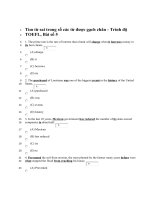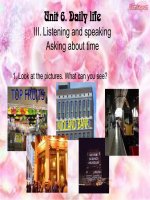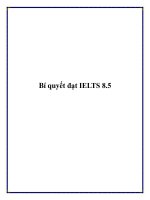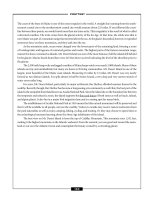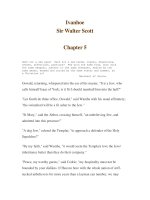reading skill 5 potx
Bạn đang xem bản rút gọn của tài liệu. Xem và tải ngay bản đầy đủ của tài liệu tại đây (59.08 KB, 6 trang )
270. The main purpose of the Chamber of Com-
merce brochure is to
a. profile the owner of Dilly’s Deli.
b. describe in detail the food served at
Dilly’s Deli.
c. encourage people to eat at Dilly’s Deli.
d. explain the historical significance of the
Dilly’s Deli Building.
Cuttlefish are intriguing little animals. The cut-
tlefish resembles a rather large squid and is, like the
octopus, a member of the order of cephalopods.
Although they are not considered the most highly
evolved of the cephalopods, they are extremely
intelligent. While observing them, it is hard to tell
who is doing the observing, you or the cuttlefish,
especially since the eye of the cuttlefish is similar
in structure to the human eye. Cuttlefish are also
highly mobile and fast creatures. They come
equipped with a small jet located just below the
tentacles that can expel water to help them move.
Ribbons of flexible fins on each side of the body
allow cuttlefish to hover, move, stop, and start.
_____________________________________ .
The cuttlefish is sometimes referred to as the
“chameleon of the sea” because it can change its
skin color and pattern instantaneously.Masters of
camouflage, they can blend into any environ-
ment for protection, but they are also capable of
the most imaginative displays of iridescent, bril-
liant color and intricate designs, which scientists
believe they use for communication and for mat-
ing displays. However, judging from the riot of
ornaments and hues cuttlefish produce, it is hard
not to believe they paint themselves so beautifully
just for the sheer joy of it. At the very least, cut-
tlefish conversation must be the most sparkling in
all the sea.
271. Which of the following sentences, if inserted
into the blank line, would best sum up the first
paragraph and lead into the next.
a. The cuttlefish can be cooked and eaten
like its less tender relatives, the squid
and octopus, but must still be tenderized
before cooking in order not to be exceed-
ingly chewy.
b. On a scuba dive when you’re observing
cuttlefish, it is best to move slowly because
cuttlefish have excellent eyesight and will
probably see you first.
c. Cuttlefish do not have an exoskeleton;
instead, their skin is covered with
chromataphors.
d. By far, their most intriguing characteristic
is their ability to change their body color
and pattern.
– NONFICTION AND INFORMATION PASSAGES–
60
272. Which of the following is correct according to
the information given in the passage?
a. Cuttlefish are a type of squid.
b. Cuttlefish use jet propulsion as one form of
locomotion.
c. The cuttlefish does not have an exoskeleton.
d. Cuttlefish are the most intelligent
cephalopods.
273. Which of the following best outlines the main
topics addressed in the passage?
a. I. Explanation of why cuttlefish are
intriguing
II. Communication skills of cuttlefish
b. I. Classification and difficulties of
observing cuttlefish
II. Scientific explanation of modes of
cuttlefish communication
c. I. Explanation of the cuttlefish’s method
of locomotion
II. Description of color displays in mating
behavior
d. I. General classification and characteristics
of cuttlefish
II. Uses and beauty of the cuttlefish’s ability
to change color
274. Which of the following best describes the pur-
pose of the author in the passage?
a. to prove the intelligence of cuttlefish
b. to explain the communication habits of
cuttlefish
c. to produce a fanciful description of the
“chameleon of the sea”
d. to describe the “chameleon of the sea”
informatively and entertainingly
– NONFICTION AND INFORMATION PASSAGES–
61
During those barren winter months, with win-
dows overlooking long-dead gardens, leafless
trees, and lawns that seem to have an ashy look
about them, nothing soothes the jangled nerves
more than the vibrant green of plants surround-
ing the living spaces of one’s home. People browse
through garden stores just to get a whiff of chloro-
phyll and to choose a plant or two to bring spring
back into their winter-gray lives.
Now there is even more of a need for “the
green,” in light of recent articles warning us of the
hazards of chemicals that we, ourselves, intro-
duce into our homes. Each time we bring clothes
home from the cleaners, we release those chemi-
cals into the closed-in air of our dwellings. Every
cleanser releases its own assortment of fumes.
Some of the chemicals are formaldehyde, chlo-
rine, benzene, styrene, etc. Read the labels on
many home products, the ingredients aren’t even
listed! During the winter, when those same win-
dows are shut tight, we breathe in these chemi-
cals—causing symptoms much like allergies. In
fact, most people probably dismiss the effects of
these chemicals simply as a flare up of some
allergy or other. The truth is that we are experi-
encing a syndrome that is called Multiple Chem-
ical Sensitivity. Now, what has this got to do with
green plants? Everything healthy! Research has
been conducted with two types of plants that
have actually removed much of these harmful
chemicals from the air.
The two plants that seem to be the best bet
for ridding one’s home of such chemicals are
ferns and palms. These plants release moisture as
part of photosynthesis and, as they do, pull
chemicals from the air into their leaves. Even
NASA has conducted some greenhouse experi-
ments for long-term space exploration. Within
hours, their plants [palms] had removed almost
all traces of formaldehyde in the room. Both
species of plants are ancient, dating back more
than a hundred million years. Another trait they
share is that they both live long lives, 100 years or
more. This we expect from trees, but ferns and
palms are plants; plants that can grow to 65 feet
in the proper setting! Even their individual leaves
live for one to two years [ferns] and one to nine
years [palms]. Perhaps it is their primal qualities
that have contributed to their ability to purify
their environment.
275. What is the main idea of the passage?
a. Our homes are full of contaminants.
b. Our allergies are caused by chemicals found
in the home.
c. All plants release moisture in the home.
d. Certain plants can purify the home of many
harmful chemicals.
276. According to the passage, when a few harmful
chemicals combine, they can
a. cause us to experience allergies.
b. cause a monumental task for homeowners.
c. contribute to a syndrome called Multiple
Chemical Sensitivity.
d. contribute to photosynthesis in plants.
277. The passage indicates that research
a. has only been conducted using specific
plants.
b. has only been conducted by NASA.
c. has not identified the sources of these
chemical impurities.
d. has only benefited long term space
exploration.
– NONFICTION AND INFORMATION PASSAGES–
62
278. The passage infers a relationship between
the antiquity of ferns and palms and their
ability to
a. live long.
b. purify the air.
c. grow leaves that live long.
d. react successfully in research experiments.
279. A good title for this passage is
a. Research in the New Millennium.
b. Home Dangers.
c. Common Houseplants May Purify Your
Home.
d. NASA Experiment Finds the Cure.
Despite their similarities, the pyramids of Egypt
and Mesoamerica seem to be unrelated because of
distinct differences in the time of construction as
well as their design and function. Historians have
discovered that the construction of the pyramids
in Egypt and Mesoamerica are separated by over
2,000 years. The Egyptians used only cut stone
quarried many miles away from the pyramid
sites—a construction method that enabled them
to construct sturdy buildings that could with-
stand the test of time.
On the other hand, the pyramids of Meso-
america were not built to withstand the ravages
of time. Rather, the step pyramids rose in tiers,
on the top of which a small temple was erected.
Unlike the Egyptians, they used irregular stones.
Also, they did not share the same basic
design function. While the Egyptian pyramids
were private tombs meant to seperate the
pharaoh’s remains from the mainstream of soci-
ety and protect him for e
ternity, the pyramids
of Mesoamerica were primarily public temples
of ritual and celebration.
280. The main idea of this passage is best summed
up in which statement?
a. Pyramids in Egypt and Mesoamerica
are similar.
b. Egyptians assisted Mesoamerican
pyramid builders.
c. Pyramids in Egypt and Mesoamerica
have distinct differences.
d. Scientists do not know who built
the pyramids.
281. This passage best supports the statement that
a. the Egyptians used stone quarried many
miles away from the pyramid site.
b. the pyramids of Mesoamerica were built to
last for eternity.
c. the Egyptian pyramids were public tombs.
d. the Egyptian and Mesoamerican pyramids
were built during the same time period.
282. The passage best supports the statement that
a. Egyptian and Mesoamerican pyramids
shared the same design function.
b. both pyramids were used as temples of rit-
ual and celebration.
c. Egyptian and Mesoamerican pyramids
shared the same construction methods.
d. Mesoamerican pyramids were used for rit-
ual and celebration.
283. The underlined word eternity in the passage
most nearly means which of the following?
a. for a short time
b. temporary
c. for all time
d. never
– NONFICTION AND INFORMATION PASSAGES–
63
Born in Joplin, Missouri, in 1902, Langston
Hughes grew up to become a prominent writer of
the black American experience. During his high
school years in Illinois, he began writing poetry.
In November 1924, he moved to Harlem, New
York, where his life and work contributed greatly
to the Harlem Renaissance of the 1920s. In his
writing, Langston Hughes portrayed black life in
America from the 1920s through the 1960s. He
wrote novels, short stories, and plays, as well as
poetry.Also, he is known for his engagement with
the world of jazz and the influence it had on his
writing, as in “Montage of a Dream Deferred.”
Hughes did not personalize his stories because he
wanted readers to draw their own conclusions
about the experiences of blacks in America.
284. Why didn’t Hughes personalize his stories?
a. He did not have enough personal
experiences.
b. He only wanted to write about the Harlem
jazz experience.
c. He wanted readers to draw their own con-
clusions about the black experience.
d. He wanted to keep his personal life a secret.
285. In his poem, “Montage of a Dream Deferred,”
what influenced his writing?
a. Renaissance music
b. his travel experience
c. his high school years
d. the world of jazz
286. Langston Hughes was known for which of the
following?
a. writing poems and plays only
b. writing novels and short stories only
c. writing plays and short stories only
d. writing novels, short stories, plays,
and poems
287. His life and work contributed greatly to which
of the following?
a. the Harlem Renaissance
b. the jazz world
c. Joplin, Missouri
d. his high school in Illinois
– NONFICTION AND INFORMATION PASSAGES–
64
T
his is a section with questions that can be applied to situations you find in everyday life. On the job,
in your school, at the train station, in the grocery store, or in many other ordinary situations, you might
find yourself trying to access information from a graph, chart, or table. You may even find situations
where you have to listen to and act upon written or verbal directions.
Unlike other sections in this book, the questions you answer in this section are based on concrete informa-
tion, rather than hidden or implied material within the text. So, the most important thing is to pay attention to
every detail. Read every set of directions as many times as necessary. Also, read the title and footnotes carefully.
The ability to completely understand directions, graphs, charts, and tables is vital in today’s Information Age,
but as you may know, it is not always easy. With a little practice, these types of questions can be the easiest. This
section gives you ample opportunity to hone your skills.
SECTION
Reading Charts
and Graphs,
Understanding
Directions
7
65


